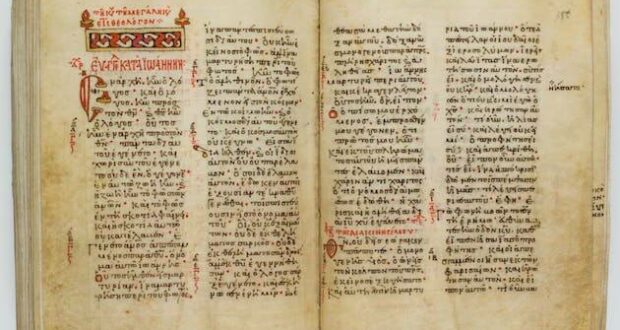The Museum of the Bible has returned a stolen manuscript to the Greek Orthodox Church. Bulgarian troops in 1917 looted the handwritten document, which is more than a thousand years old.
Museum curator Brian Hyland identified the manuscript, one of the world’s oldest hand-lettered gospels, as part of hundreds of priceless objects looted from the Kosinitza Monastery in Greece during World War I, the museum said in a statement, adding that it had purchased it at a Christie’s auction in 2011. The manuscript had been used for hundreds of years in religious services, along with more than 400 volumes, before being taken by Bulgarian forces.
In 2020, the museum informed Ecumenical Patriarch Bartholomew I, the world leader of the Eastern Orthodox Church, about the intended return of the manuscript, which entered the museum’s collection in 2014. The patriarch allowed the museum to display the manuscript from October 2021 onward. The patriarch also loaned three more manuscripts “as part of the collaboration in a permanent exhibit at the museum as a gesture of gratitude for the gospel manuscript’s return,” the museum said.
The museum, which has investigated all of its collections in recent years, said it “hopes that other collections in the U.S. that also possess manuscripts from the monastery will likewise voluntarily return them to their rightful home.”
“Certainly the marketplace has its challenges,” said Jeffrey Kloha, the museum’s chief curatorial officer. “Things have been moving in the market for some time, and in some cases decades, that have origins that are not legal. The procedures in place now are very, very tight. If we don’t have every detail filled in, it’s simply not considered. The process is very different than it was 10 years ago.”
In an interview with The New York Times, Tess Davis, executive director of the Antiquities Coalition, said, “I think the Museum of the Bible is a great example of how not to build a collection, but I do wish other American museums would follow its example when dealing with their own existing problematic collections.”
Davis also said that most ancient artifacts in virtually every museum were originally stolen. That fact, she states, makes it difficult for buyers add to their collections. The Museum of the Bible has been working to return other looted objects.
It has been lauded for its willingness to return priceless artifacts for which it has paid millions of dollars. Many secular museums refuse to return pieces even after they’ve been investigated as previously stolen.
–Dwight Widaman | Metro Voice
 Metro Voice News Celebrating Faith, Family & Community
Metro Voice News Celebrating Faith, Family & Community









